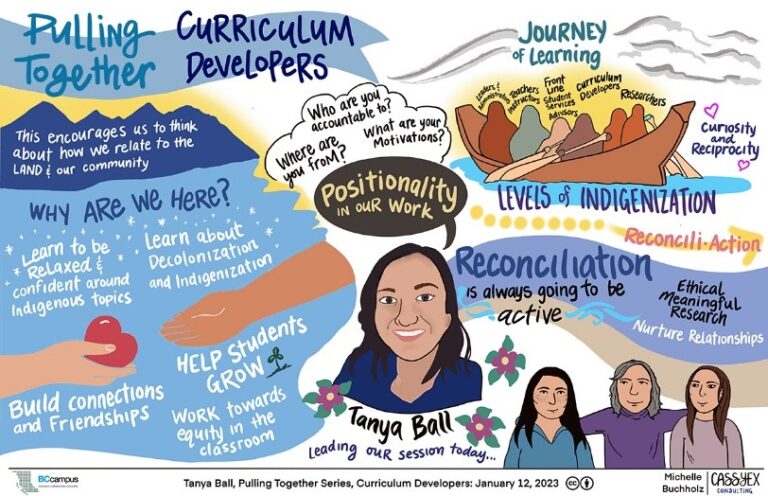Engagement is Not a Drive-Through
This week, Lesley and Seanna have teamed up to share some new thoughts on engagement. In the right hands, amazing things can be done with online activities, discussions, and assessments. The BIG DEAL though: yours are not the only hands. Engagement is grown by everyone in the class by taking our time in knowing and working with each other.
As we work with Faculty on engagement, we can see that engagement can mean different things to different people. For some, it’s the feeling that we want to “show up”. For others, it’s having students’ rapt attention. It’s an interesting activity or brain teaser; a hook to start the class. It can be asking questions or contributing thoughtfully to discussions. And how do we know students are engaged? We can see them. We can observe facial expressions and posture. We can hear them ask questions and gauge responses. Move it all online and POOF – your data source is gone. Prominent researcher and advocate in UDL, Allison Posey recently described the grief that accompanies the shift to online learning: the grief for our cherished practices and cherished connections, face to face with students.
Try to take heart that you’ll get back there soon. It’s only goodnight, not goodbye in the words of Gilbert Grape.
In the meantime, here are three wonderful ways that you can get to a good engagement place for both you and your students.
Wonderful Way #1
Building Community is at the Heart of Learning
Are you teaching the course or the students? If we are teaching students we need connection – connection between us and individual students and between students. Building a community can feel like making decisions together and knowing who to look to next when you’re stuck or excited.
In Practice:
Example 1. Plan good icebreakers and use them throughout the course.Creating a method to help students know each other will have a big impact. Here are some links to icebreakers you might choose to use.
Example 2. Create an introduction forum e.g. In a forum post, or with an attached video clip or photo series if you prefer, tell us: what your favourite course has been, what your super power is or what is a hobby or something you’ve had more time for during COVID and social isolating.
Example 3. Create bonus off-topic forums that invite students to continue building connections to you and one another, such as this Question of the Day activity. Consider setting up a Maker Space in Moodle where students informally discuss what they are really trying to say/do/think and where they can ask absurd, tangential, or risky questions to connect ideas.
Wonderful Way #2
Support Deep Learning by Opening Up, Not Boxing In
By definition, deep learning is connected to engagement. Deep learning happens when we make multiple connections in multiple ways to multiple sources of information to make sense of problems and questions. Rigour arises through the development of a critically voracious learning community, according to Jesse Stommel and Sean Michael Morris. Support engagement wonderfully by designing so students look out and around.
In practice:
Example 1. Invite community and industry experts into your course. Short 5-minute videos can provide a career perspective on a topic you are addressing in the course.
Example 2. Bring different voices into your course. Ask students to brainstorm all the ideas, models, skills, approaches that they’ve learned in other courses or places that they could bring to this course. Collaborate with other instructors. Pull in podcasts, TED talks, and blog posts. Some KPU instructors are already preparing voice-over PowerPoints together; consider teaming up and becoming interdisciplinary.
Example 3. Design activities where students integrate multiple sources of information (writing, images, films, movie clips). By collecting and curating sources together, students have the opportunity to make choices, and create deeper connection and meaning with each other, with you, and with the course. For instance, have students design a gallery of images that reflect themes in a text, or create a community video to show where students could apply or locate a theoretical framework.
Wonderful Way #3
Finding Meaning and Joy
Engagement grows from openness, perspective-taking, and joy. Sometimes we think of activities as being fun. What we’re suggesting is moving into a sense of joy which is more enduring, more meaningful. Even when the work is tough, we still have joy in being open, understanding each other, and pulling together.
In practice:
Example 1. Acknowledge that the semester may hold difficulties. Reassure students that we’ll keep talking about access, help and working together. Have students brainstorm barriers and find solutions up front. An example of this might be having students work in teams to identify:
· How they prefer to seek help
· What they anticipate they will be good at/not so good at
· The best kind of support they have experienced in the past year
· What worries/fears they have about the course or the semester
· What barriers they might encounter and how we can reduce them together.
Example 2. Use storytelling. Students enjoy sharing stories, but also like to hear your own experiences and curiosities. Modelling humanness is a key part of the experience and creating space for storytelling is an important part of the joy of learning.
Example 3. Consider video feedback to accompany written feedback. Video and auditory feedback can support a sense of familiarity and friendliness. Consider the same for peer-feedback. You can easily create video feedback using Kaltura Capture, then embedding it in the comment section when you grade the student’s assignment.
Community, opening up and meaning are three avenues to creating engaging learning environments. There are many more ways to foster engagement – ask your students and bring your true personality and style to your course. And as always, we’re here to help.



